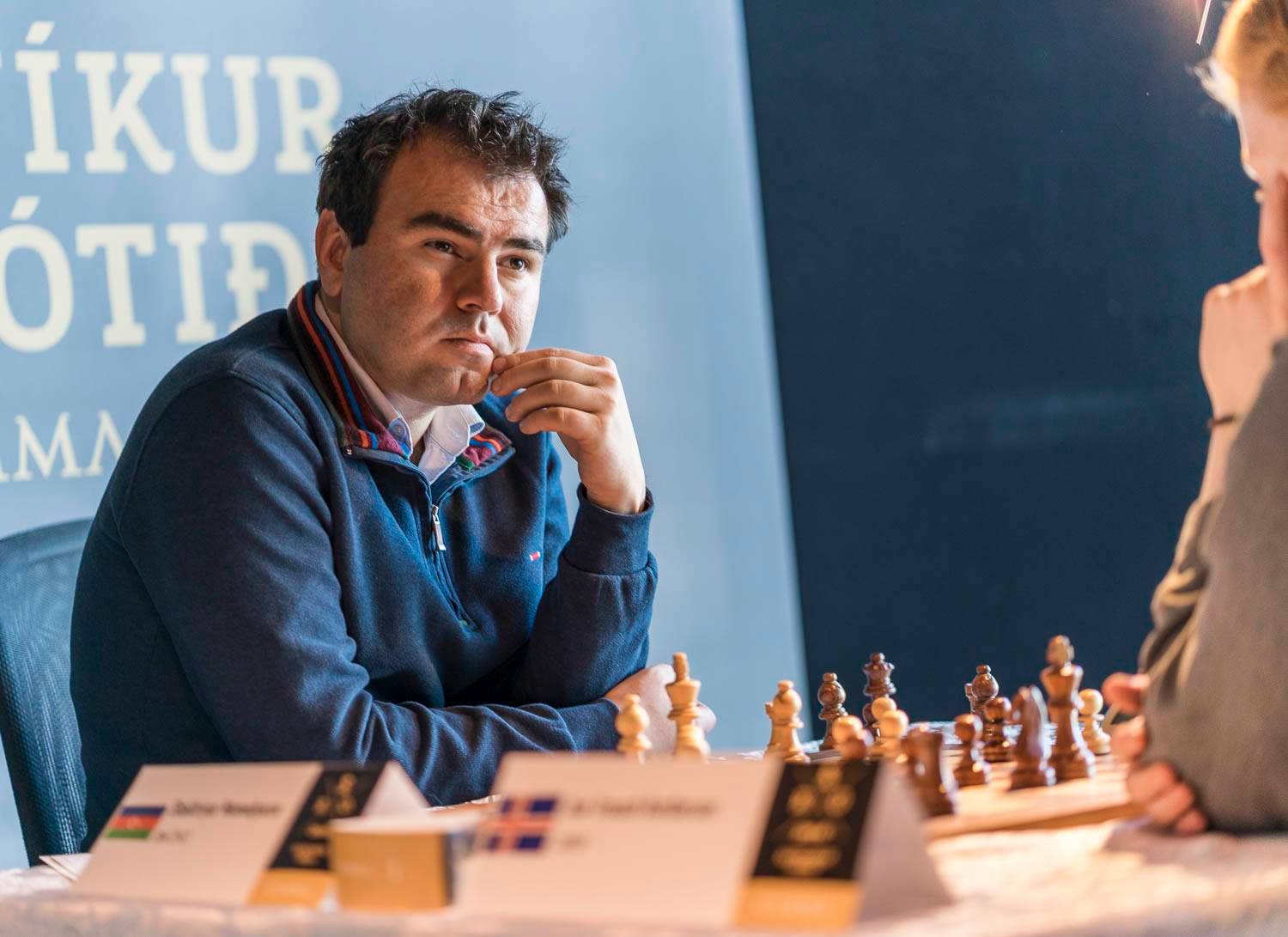The fourth round of the 31st edition of the Reykjavik Open saw its first grandmaster versus grandmaster clashes and there was plenty of fighting spirit shown as the top seeds wished to put forward their case to be crowned as champion in 2016. On board one Alexander Shabalov may be entering his “twilight” years as a top player but the will and hunger are still there as he pushed around fifth seed Ivan Cheparinov in a g3 Grunfeld but the openings popularity in top level chess seems to be justified as white could not achieve anything substantial. The American GM managed to win a pawn but the game was always under control by the Bulgarian GM and they drew in a long drawn out 87 moves. Menawhile other top board games had decisive results in a much shorter number!
Englsih grandmaster Gawain Jones had to face the “Polar Bear” opening by Icelandic GM Henrik Danielsen, this unusual opening is basically the Leningrad Dutch with reversed colors but Jones decided to transpose the game more into a closed Sicilian structure by advancing his d pawn only one square. The first interesting moment comes about in an aesthetic looking position.
It is not often you see three files being perfect mirror images of each other! Assuming they cancel each other out then you look at the remaining pieces and who seems to hold better placed squares then their corresponding counterparts, the knight on d4 is more active then the knight on d1, the rook on a1 looks more active then the one on b8 and the pawn on b4 has gained space as opposed to the vulnerable looking on b2. Chess evaluations though are not normally done only in this way since the spectre of tactics will always have the last word.
Danielsen did not sense any danger and played 17.Rxf8+,Qxf8 and then played the active looking 18.Ra7 attacking the e pawn already attacked by the bishop on g5 as to emphasise the extra mobility of his “a” rook compared to the one on b8. Unfortunately it is a blunder in an already dangerous position.
One of the first elements of chess is to always look at “forcing moves”, checks and captures, practise them till it feels like the multiplication tables. Gawain Jones is an excellent tactician with an aggressive attitude making him a very dangerous opponent for anyone and he sees the complicated win starting with 18,…Ne2+ 19.Kh1, N(any)xg3! 20.hxg3, Nxg3+ and then after 21.Kg1 the English GM repeated moves once to double check his calculations came the hammer blow 22,..Bd4+ 23.Be3, Ne2+ 24.Kh1, Qf6!
The loose knight on h4 is attacked and has no good retreat square, the white king is about to get mated, Danielsen played 25.Qe1 but after 25,..Be5 he resigned.
Abhijeet Gupta continued his impressive form by showing the trumps of the Catalan opening, the slight extra space and the famous influence of the fianchettoed bishop on g2. Easier to show a couple of snapshots.
Domination!
Execution with 24.Be7! The Russian IM Nikita Petrov was forced to resign after 24,…Nc6 25.Rxc6! bxc6 26.Bxc6. Somewhat fittingly that the Catalan bishop is allowed to deliver the final blow, The clash between Jones and Gupta as the only two remaining players on a perfect score promises to be a mouthwatering clash.
Top seed Shakh Mamedyarov fresh from his half point bye continued his impressive form by defeating American IM Justin Sarkar in a sharp Grunfeld g3 line. The critical moment seems to be the following.
Mamedyarov has just played 28.Bf1 and the first thing you notice is the fact that both sides have rooks under attack from minor pieces but the top seed is not thinking about material, he has decided that his trump is his d-pawn and that the rook on d6 is a bad blockader. Sarkar took the rook with 28,…Bxb5 but it seems his last chance was to muddy the waters with the pawn thrust 28,…e3! leading to a very unclear position. Instead the d-pawn was allowed to push forward and cut the board in half opening up greater possibilities of the top Azerbajani GM’s pieces.
After 34,d7! Black has no good square for his rook to protect the knight apart from 34,…Rc5 and then Mamedyarov had various choices as to the killing blow, his choice of 35.Rc1 was good enough to force resignation but 35,Bg5 looks quite prosaic as well. An impressive show of power chess from the top seed.
Richard Rapport played for him a rather “safe” opening in the shape of the black side of the Queens Gambit Declined and it was his opponent, the Icelandic IM Gudmundur Kjartansson, who was the player who steered the game into an unusual position by leaving his king in the center while pushing his pawns on the kingside.
Unfortunately for fans of the Icelandic IM his slight space advantage is negated by the completely unsafe situation of his own king. Rapport opened the center with 20,…cxd4 and 21,…Nc4 forcing white to castle queenside but with the black queenside pawns already advanced and the rook already on c8 it led to a quick attack which was handled very efficiently by the young Hungarian.
There were some interesting moments on other boards as well, young Norwegian GM elect Aryan Tari was trying to find a way past one of the top female players in the Reykjavik open in the form of IM Tania Sachdev from India. After a quiet Spanish opening and balanced middlegame Tari has gone for the “active king” approach in teh endgame.
After whites last move 41.Ke6 black is forced to play 41,…g6 creating some luft for her king. It seems only one player is playing for the win here but then witness the game a few more moves later
Tari has just played 47.f4 but here Sachdev threw a spanner into the young Norwegians plans with 47,…Rxb3! creating a duo of pawns hurtling towards the finish line of the eighth rank. The critical decision is which pawn to push first and where to put the black king, some choices for the chess analysts out there.
The key is that at some stage black will promote a pawn but he has to prevent white keeping one white pawn and then combining this with his rook building a fortress where the black queen cannot make any progress. There is also the issue of white achieving a white pawn on f7 to secure the famous theoretical drawn position there as well.
In the end it ended up like this version which allowed white to achieve a fortress, it would be interesting to see if there was a way to promote to a queen and manage to win all the white pawns.
The position was agreed a draw a few moves later but it proves that the beauty and intricacy of chess is not only limited to exciting middlegames!
One of the most exciting and complicated positions was created by the match up of German GM Stefan Bromberger versus the local player Gudmundur Gislason. There is usually one moment where as a chessplayer you seem to have at least two good choices and with the clock ticking you have to make a decision. Looking at the following postion from whites point of view, Black seems to have a deadly threat of Ne4+ but you can play f6 or d6 with attractive looking threats. You look at the clock and then you wonder why you took cxb4 a couple of moves earlier allowing the black rook access to the a2 pawn. The truth is that position is still equal but 43.d6 seems to be the one which gives black the most problems.
After 43.d6 you calculate 43,..Ne4+ 44.Kg1,Nxg3 45.d7. not only forks two pieces but after 45,..Bxd7 46.exd7, Rd8 you have Bd5+ winning the rook on a2 but then after Nxh1 (or Ne2+ and Nxc1) you are still not winning!
In the end 43.f6 was played which led to a draw after 43,…Ne4+ and 44,,.Nxf6 but still an incredibly interestingly complicated game for the chess enthusiasts to play through
Four top 25 board results. The full list can be seen here.
To see round five pairings of the round that will start at 3:00pm local time click here.













